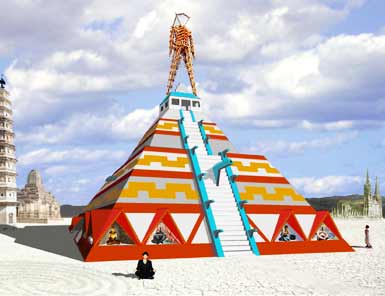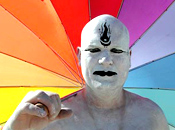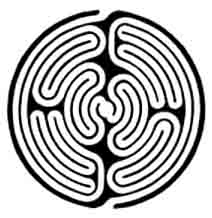“What is any religion? A little ritual, a little superstition, and some magic. It’s not a strictly spiritual affair; it has psychological roles to fulfill. You might not want it to be a religion based on your own experience but that’s like wanting to clean up your dreams.” — Gary Snyder
Beyond belief, beyond the dogmas, creeds, and metaphysical ideas of religion, there is immediate experience. It is from this primal world that living faith arises. The intention of Beyond Belief is to explore this mystery. In 2003, we will invite participants to create interactive rites, ritual processions, elaborate images, shrines, icons, temples, and visions. Our theme will occupy that ambiguous territory that lies between reverence and ridicule, faith and belief, the absurd and the stunningly sublime. The human urge to make events, objects, actions, and personalities sacred is protean. It can fix on and inhabit anyone or anything. This year our art theme will release that spirit in the Black Rock Desert.
A Search for the Sacred
“There is no formal difference between play and ritual, so the consecrated spot cannot be formally distinguished from the playground. The arena, the card table, the magic circle… all are in form and function playgrounds, i.e. forbidden spots, isolated, hedged round, hallowed, within which special rules obtain. All are temporary worlds within the ordinary world, dedicated to the performance of an act apart.” — Johan Huizinga
Sacred things appear to come from some profoundly other place that is beyond the bounds of space and time. It is as if a window is thrown open on another world that is more real than real. This absolute uniqueness of all sacred things releases powerful emotions: joy, awe, wonder, dread, and, in its most transcendent form, pure exaltation. The sacred speaks to us of vastness and of union with a power larger than our conscious selves. The sacred gives us access, it is felt, to greater being. Yet whether sacred things are really real is always open to examination. Beyond Belief asks two related questions: How does the sacred exist, and where might it be found?
This year’s theme is an attempt to reinvent the quality of faith as it inspires the creation of religion. Our purpose is to disregard assertions of belief and concentrate instead on the experience of play. Beliefs contain, define, and limit meaning. They reduce truth to a rational commodity. But play can free us to envision truths of which we have no proof or warrant. Such play, as we conceive it, breaks down the distinction that divides belief from make-believe. Whole-hearted play induces self-surrender to realities beyond the scope of reasoned thought. Beyond Belief invites you to attend to what is deep within you and unite it with a world we can’t possess.
Sacred and Profane
“Mystical states, when fully developed, usually are, and have the right to be, absolutely authoritative over the individuals to whom they come, [but] no authority emanates from them which should make it a duty for those who stand outside of them to accept their revelations uncritically.” — William James
This year we’ll name the curving streets that form the arc of Black Rock City after concepts of belief. Our city’s radial streets, which divide this semicircle into sections, will be labeled according to time as displayed on the face of a clock, starting with 10:00 and ending at 2:00. In addition, these same streets will be labeled with adjectives that can be used to qualify belief. Our city plan will thus become an enormous phrase generator. The intersections of this street grid will yield 172 combinations of paired words. When asked where you are in 2003, you may state that you stand firmly on Authority somewhere between Real and Imagined.
Concentric Streets:
(ordered alphabetically)
The Esplanade
Authority
Creed
Dogma
Evidence
Faith
Gospel
Reality
Theory
Vision
Radial Streets:
10:00 — Sacred
9:30 — Profane
9:00 — Real
8:30 — Imagined
8:00 — Revered
7:30 — Ridiculous
7:00 — Literal
6:30 — Sublime
6:00 — Paradox
5:30 — Certain
5:00 — Dubious
4:30 — Inspired
4:00 — Received
3:30 — Serious
3:00 — Absurd
2:30 — Revealed
2:00 — Rational
This naming system will create a dialectic filled with ever-changing points of view and contradictions. Central to this system is the street forming the axis of our city. This street will be designated as a paradox: a statement or idea, self-contradictory and opposed to common sense, which might express truth.

Temples on a Plain
“We recognize the [sacred] as an indispensable aspect of all periodical observances — [and] of all institutions religion has the strongest claim to being in charge [of this]: the believer, by appropriate gestures, confesses his dependence and his child-like faith and seeks, by appropriate offerings, to secure the privilege of being lifted up to the very bosom of the divine. — [This] assures us of separateness transcended and yet also a distinctiveness confirmed, and thus the very basis of a sense of ‘I,’ renewed (as it feels) by the mutual recognition of all ‘I’s joined in shared faith in one all embracing ‘I am.'” — Erik Erikson
Throughout the course of history humans have sought out sacredness in many different ways and places. We have made of it an object of both prayer and contemplation. We have exalted it high overhead and hidden it deep underground. We have embodied it in ritual and housed it in temples. At this year’s Burning Man, we will erect a temple at the geographic center of our city. We will consider it to mark an axis mundi — that type of cosmic center that was anciently believed to be the origin of all existence. Such sacred spaces were regarded as engendering the underlying order of the universe.

Four broad ceremonial avenues will stretch outward from this cosmologic center toward the four horizons. We urge you to unite with others in processions on these promenades. Sorrowful or solemn, ecstatic or eerie, penitential or joyous — in any mood or manner that expresses sacredness — these interactive rites will culminate within the circle that surrounds our pyramidal temple. If you plan a procession or a ritual performance that features fire, involves the use of moving vehicles, or in any way incorporates the structure of the pyramid, please contact processions.burningman.com.
 A hallowed boundary of raked sand will frame the pyramid, and sixteen niches will surround its base. Any participant may occupy a niche and be transformed into a living icon. A Guardian will guide you through the temple to your niche. Passersby who witness you enshrined will be invited to leave offerings as tributes to your special presence in this space. In order to fulfill this role, you must adopt a sanctified persona (body paint and costuming are highly recommended).
A hallowed boundary of raked sand will frame the pyramid, and sixteen niches will surround its base. Any participant may occupy a niche and be transformed into a living icon. A Guardian will guide you through the temple to your niche. Passersby who witness you enshrined will be invited to leave offerings as tributes to your special presence in this space. In order to fulfill this role, you must adopt a sanctified persona (body paint and costuming are highly recommended).
Pantomime gods will also be welcome in the temple niches. These icons must be larger than a breadbox, but may not exceed the stature of a human being. All submissions will be juried in advance of the event. If you wish to create a pantomime god and display it in a temple niche, please contact pantomimegods@burningman.com. If you would like to become a Temple Guardian and aid in creating and maintaining the sand garden that borders the temple, help others to be living icons, or help us to preserve the sanctity and safety of this place, contact templeguardians@burningman.com.

Deep inside the pyramid, inner sanctums will house altars. These altars will be dedicated to the passage of gifts. For our special purpose, we will imagine such gifts to be bearers of being. Whatever you may choose to place upon an altar should excite a sense of wonder or delight in those who witness it and may express any of the vast variety of feelings we associate with sacrificial acts. These sacrificial objects may not exceed a handbreadth in any dimension or contain toxics. Sanctum, shrine, and offerings will be consumed by fire when the Man is burned.
This year the figure of the Burning Man will be accessible to everyone. You will ascend a great stairway, its foot-high treads forcing you to take giant steps. Slowly you will labor upward toward a chamber on the temple’s topmost tier. The center of this chamber will be marked by an omphallos — a world navel. It will perfectly align upon a common axis with the spine of Burning Man. From here you may gaze out upon our world and all those who inhabit it. Immediately below this view of our city, your eyes will come to rest upon the outline of a labyrinth.

Labyrinths are of extremely ancient origin, and no one can reliably decipher what they’re meant to represent. Some say if you ask a question as you enter one, you will receive an answer when you leave. But this is only one of many possible interpretations. Unlike the puzzle of a maze, a labyrinth is not about becoming lost, nor does it tempt one with what’s hidden out of view. No treasure or desired object forms a goal. You find yourself upon a path, forever turning in and turning out and coiling round, forever orbiting the blankness of the mystery at its core. Finally, you discover that your purpose is not separate from the path itself. If you plan a large procession or performance that incorporates the labyrinth, please contact processions@burningman.com.
Beyond the precincts of this temple complex at the center of our world, participants will spy the clustered towers of a second temple near the far horizon. The Temple of Honor will be dedicated to the passage of spirits. You are invited to bring relics to this shrine. Messages may be inscribed upon its paper walls as tribute to the lives of loved ones you have lost. On the seventh night of our event, the temple will be set afire.

The Temple of Honor will mark the outermost edge of the earthly plane. Participants who pass beyond it will escape into a void where all things that we know, rely on, measure, or believe in lose their relevance. This is the landscape of epiphany. All things that reside within it are called wholly other.
The Realm of the Wholly Other
“Imagine, then, by miracle, with me,
(Ambiguous gifts, as what gods give must be)
What could not possibly be there,
And learn a style from despair.” — William Empson
Odd things don’t fit in. Like the thirteenth egg in a dozen, they violate a category that gives order to our world. Strange things are considered odd, but also challenge explanation. A square egg, for example, would be strange. Weird things are not only odd and lack a ready explanation; in addition, they repel all possible attempts at explanation. They contradict a fundamental law that governs what we think of as reality. An egg that floated in midair or talked to you in confidential tones about your childhood would certainly seem weird. At each stage within this series of extraordinary states the context of our world is stretched and sloughed away. When we extend this process one step further — going beyond the odd, the strange, and the weird – we cross a final boundary line. We arrive, at last, in the Realm of the Wholly Other.
Hear Larry Harvey and the Very Reverend Alan Jones engage in a dialogue entitled “Radical Ritual”, a part of Grace Cathedral’s “Forum Series”.All things in this wholly other world are visions. They cannot be defined by light that falls upon them. Instead, they radiate a kind of inner light that shines through us. They have the quality of what is called the numinous — a unique glamour, a luminous potency, an eerie kind of presence that is said to mark the advent of a sacred thing. Such visions are embodiments of unconditional reality, and through our act of witness, it is said, they can transfigure what we are.
Beginning with the dawn of human consciousness, mystics have sought out this realm of super-charged experience. They have retreated into caves, removed themselves to mountaintops, and disappeared into the solitude of desert space. They have relentlessly emptied themselves of our world; they have fasted, prayed, and kept vigils — all in a pursuit of that which cannot be compared to any other thing. What these pilgrims have encountered on their outward journeys into nothingness is matter for conjecture. The only proper answer of the faithful to the skeptic is that one must be there if one hopes to understand.
In the year 2003, we’ll populate this world beyond our world with artworks that evoke such visions. Other theme-related artworks will line the processional ways that converge on the Great Temple. If you plan to create a work of art that in some way expresses the spirit of Beyond Belief, please contact themeart@burningman.com.
As in all previous years, artworks unrelated to our theme are also welcome at Burning Man. We’ll site whatever you create within the open space before our city. If you wish to install such a work, please contact installations@burningman.com.

